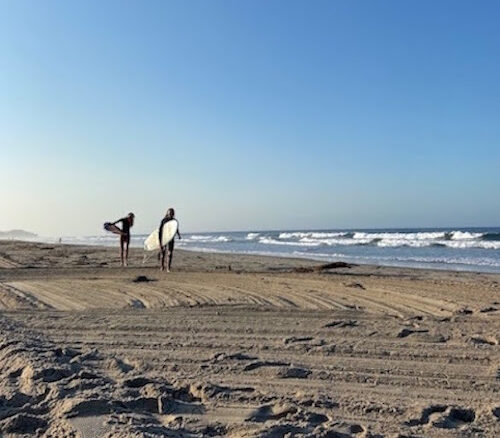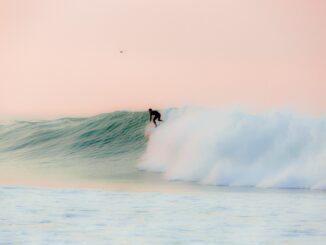
Males dominate the sport of surfing, and this is particularly true at the beaches in Malibu.
As a female surfer in Malibu, being the lone girl in the water can be intimidating, stressful and can even take the fun out of it.
Cayla Moore, editorial coordinator at World Surf League and Pepperdine surf team graduate, said surfing is supposed to be for everyone, but men fill Malibu’s waters, creating a territorial environment that makes females feel unwelcome.
“When I’m surfing out in Malibu sometimes it’s just me, I’m the only girl and it can be kind of intimidating,” Moore said. “But I try to kinda use it to my advantage in one way or another.”
This issue goes back to the beginning of this sport and continues to challenge women in the surfing world today. It is a sad reality for many female surfers in Malibu as they challenge the stereotypes and sexist attitudes that are associated with surfing.
Number of male and female surfers in Malibu recorded
A week-long study of five Malibu beaches found that, on average, men regularly outnumbered women 10 to one or more at three out of the five beaches.
This map shows the average recordings for how many male and female surfers were present in the water at these different beaches.
The beach with the most women present was First Point, a beach that Moore said has the highest numbers of women surfing. This is due to the fact that it is a beginner spot, with slow and rolling waves that are easy to ride. It is primarily a longboarding spot with not as many shortboarders.
When learning how to surf, most people will begin on a longboard since it is easier to ride. While many men progress from a longboard to a shorter board, Moore said the majority of females she sees in Malibu continue to longboard because it is easier, more comfortable and still fun.
“If I’m not the only girl in the water, I’m definitely the only shortboarding girl in the water,” Moore said. “In Malibu, the majority of girls get into longboarding and go to First Point because it is more of a beginner spot and easier to paddle, catch and ride waves.”
Zuma Beach also had more females than the other beaches, and that is because it is a place where many people go to learn. The majority of the females counted at this beach were beginners.
Staircase beach displayed the most male dominance, as there was rarely a woman surfing there when the data was recorded each day.

Female surfers speak about their experiences with tension and localism in Malibu
“Sport is supposed to set you free, not make you feel you have to be objectified to participate,” female surfer Sophie Hellyer said in an interview with Surf Simply. “I believe what we see, we can be. I speak to young girls who don’t see female surfers in the films about our coast and they question their place in the surfing world and whether they should be doing it at all.”
While women’s recognition in the sport of surfing has improved since the late 1970s, there are still many tensions and expectations when it comes to female surfers, specifically in Malibu.
Lily Dyer, a senior business administration major and avid surfer, said she feels like she has to prove herself and constantly have her guard up when she is surfing so that she won’t get pushed around, cut off on waves and not respected since she is the only girl out there.
“I feel like I have to go out and assert my dominance and be kinda tough at first in order to not let the males there push me around, cut me off, or disregard me since I am a female,” Dyer said. “I can’t just go out and be the “happy sally” that’s sweet to everyone and says hi to all the men just because I’m a girl and that’s what I’m expected to do.”
Moore is almost always the only girl in the water and often experiences sexist stereotypes first hand.
“I’ll get hassled like right away and it’ll be really frustrating for me because I can tell the guys don’t think I know how to surf,” Moore said. “They kind of already have a view in their head that I’m a girl and I don’t really know what I’m doing. But then they kind of leave me alone after I catch my first wave.”
Moore and Dyer are not the only women who feel this way as Ashley Hume, an Azusa Pacific University freshman, said when she is out surfing in Malibu, men always outnumber her at about a 10 to one ratio..
Hume surfs in Malibu almost everyday and thinks the city is even more male dominated and territorial than other cities where she surfs, such as San Clemente.
“In Malibu there is more of this pressure and judgment if you’re not from around there,” Hume said. “People can almost become territorial in the water, which is not what I’ve experienced in San Clemente.”
Gross agreed that there are lots of locals in Malibu who, when they’re surfing, believe that surfing is their sport and that they always have priority, and that can definitely be intimidating for women.
Why is surfing a male-dominated sport
Traditionally, surfing was solely a male sport. Much of this was due to the fact that original surfboards were made of wood and weighed more than 100 pounds, making them very heavy and often impossible for women to carry, according to surfboard shaper Kun Tiqi.
Even if a woman could get her hand on a board to ride, opportunities were scarce and the idea of a woman surfing was widely unacceptable.
“Up until the 1900s, magazines and filmmakers largely ignored female surfers; there were no wetsuits or swimsuits designed for women and prize money was a small fraction of men’s,” Brian Tissot, a marine ecologist at Humboldt Marine and Coastal Science Institute, wrote in a Feb. 24 post on his blogpost.
Since then, there has been a push for gender equality within the sport of surfing, reaching equal prize money for female and male competitors in 2019.
“Now a push to go further is opening a broader debate over how to advance equality for women in male-dominated sports—and whether all-female competitions should be open to men,” Laurel Rosenhall wrote in a March 2019 KCBX News article.
Moore wrote an article for the World Surf League in which she honors the early women who fought for surfing equality.
“A lot of the people who started the sport for women were never talked about, photographed, written about or featured in magazines,” Moore said. “Competitions didn’t start for women until 1977 and even so, the first year didn’t have very many contests,versus the men who had a whole tour put together.”
Dyer said another reason that surfing is a male-dominated sport is because of the safety factor for females.
“Compared to boys, it’s not exactly safe to send girls out when they’re young into the water to surf by themselves or even in a group of friends without a dad or protector of some sort with them, which means less girls in the water,” Dyer said. “It can be tougher for a woman or girl of any age to just go out and surf by herself for reasons like safety, both in and out of the water,”
Brandon Gross, ocean lifeguard for the L.A. County Fire Department and a Malibu local, said males dominate the Malibu lineups, and attributed this to the long history of extreme sports such as skateboarding, snowboarding and surfing, in which the most recognized and respected figures were always men.
From a male’s perspective
Since Gross is a regular lifeguard at Zuma Beach in Malibu, he is able to observe surfers on a daily basis.
“I would definitely say when I’m working the beach and lifeguarding, that the majority of the surfers out there are male,” Gross said. “I wouldn’t say all of them but I would say the majority of them. On a flat day when there’s not much going on out in the water, when there’s not much activity, there are females, usually more on the beginner side, but they’re out there.”
Justin Trucshke, senior member of the Pepperdine surf team and advertising major, said he has never seen a spot in Malibu where there are more than, or even close to, the same amount of females in the water as there are men.
“There are definitely guys who will be like ‘Oh, there’s a girl with priority? Screw that’ and will drop in on them just because they’re a girl,” Truschke said. “I know some guys who will cut girls off just because they’re girls.”
Both Gross and Truschke shared an appreciation for women in surfing. They say they are hyped to see women surfing and appreciate the different perspective that it brings.
“We’re all out there for the same reasons to get outside, to have fun, to catch some good waves,” Gross said. “You should be stoked when you catch a good wave and you should also be stoked for someone else when they catch a good wave, whether they’re male or female.”
Shelby Little completed the reporting for this story in Jour 241 in Fall 2021 under the supervision of Dr. Christina Littlefield and Dr. Theresa de los Santos. Dr. Littlefield supervised the web version of the story.




